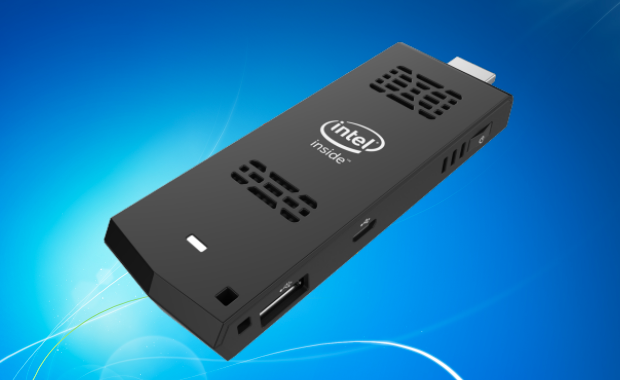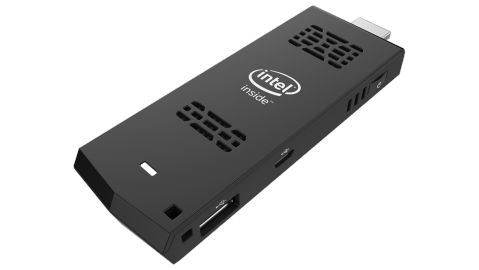

Intel CEO Brian Krzanich made a lot of important announcements when he delivered his company’s keynote address at CES yesterday. Not only does he plan to invest $300 million to encourage diversity in the technology industry, but he also outlined what the future of computing will be like for consumers.
And it will be small — very small.
The Compute Stick is the Next Generation of Computing
Among the devices Intel announced is the Compute Stick — a tiny dongle that can turn any HDMI display into a fully functioning computer. But unlike other HDMI dongles like the Google Chromecast and Roku 3500R, the Compute Stick does a lot more than simply stream media.
It can also do (almost) anything your desktop PC can.

The Compute Stick
Intel Compute Stick Specs
- Operating System – Windows 8.1 or Linux
- SoC – Intel Atom “Bay Trail” quad-core processor
- System Memory – 2GB RAM (Windows) or 1GB RAM (Linux)
- Storage – 32GB eMMC (Windows) or 8GB eMMC (Linux) + microSD slot
- Video & Audio Output – HDMI
- Connectivity – 802.11 b/g/n Wi-Fi and Bluetooth 4.0
- USB – 1x USB 2.0 port, 1x micro USB port for power
- Power Supply – 5V/2A via micro USB port
- Dimensions & Weight – 4 inches long
With a relatively low price tag of $149 for the Windows version and $89 for the Linux variant, the Compute Stick could potentially be widely adopted and for various uses. It could also revolutionize the way we access information and redefine what a personal computer really is.
The Compute Stick seems to be the perfect solution for consumers who need a computer with enough power to perform tasks like browsing the web, social networking, and light productivity. On the business front, it could provide portable Remote Desktop support with plug-and-play simplicity. There are literally endless possibilities for the Compute Stick and Intel believes it could also be used in conjunction with our other devices.
“The rise of new personal computing experiences, intelligent and connected devices, and the wearable revolution are redefining the relationship between consumers and technology. Our goal with Intel technology is to help solve real problems and enable experiences that are truly desired by people and businesses.”
— Brian Krzanich, Intel CEO
Mr. Krzanich wasn’t kidding when he said he wants to “redefine the relationship between consumers and technology.” And if his predictions are correct, computing with a screen, keyboard, and mouse will soon be a thing of the past.
The Computers of the Future Won’t Look Like Computers
Other Intel products that were announced at CES include a button-sized wearable computer module called Curie along with new applications for RealSense cameras. Intel foresees these devices working together in a future where “robots, drones and 3D-immersive experiences” are an everyday part of life. If true, we’ll never think of computers the same way again.
Intel’s claims are not outlandish when you consider the wearable revolution is already upon us and drones are officially part of the mainstream consciousness. And as personal computing becomes even more advanced it’s only a matter of time before we reconsider what a computer actually is.
It’s not hard to imagine using a computer without connecting to peripherals because we already do it. Smartphones, tablets, and even our cars are capable of performing many of the same tasks that once required an entire system of connected hardware. Intel is simply stretching this technology further and ushering in the next generation of computing with its new products.
Notable Intel Product Announcements at CES 2015
Curie: A tiny hardware product based on the company’s first purpose-built SoC for wearable devices. The module is scheduled to ship in the second half of this year and includes the Intel Quark SE SoC, Bluetooth low-energy radio, sensors and battery charging.
Wearable Collaborations: Oakley is the first Luxottica Group brand that Intel is working with to fuse premium, luxury and sports eyewear with smart technology. Krzanich was joined on stage by Colin Baden, CEO of Oakley, who said the companies are “working on an intelligent product, available later this year, designed to enhance athletes’ performance.” Intel also has initiatives with Basis Peak, Fossil Group, Opening Ceremony, and SMS Audio.
Nixie: The 2014 “Make it Wearable” challenge winner and the first wearable camera that can fly. Nixie rests on your wrist like a bracelet, then unfolds and takes flight on cue to take the perfect shot of you in the moment.
TrueKey: A newly announced cross-platform application by Intel Security to address the hassle of passwords. The True Key application uses personal factors like the face, device or fingerprint to make logging in easier and safer.
Wireless Charging Collaborations: Krzanich also highlighted new wireless charging collaborations with Hilton, Jaguar Land Rover, San Francisco International Airport, and Marriott. These collaborators are planning wireless charging pilots, development, and deployments. Marriott already has plans to pilot wireless charging capabilities across their portfolio of brands.
Intel isn’t just speculating on what’s next for personal computing; they’re focused on where it is and where it’s going. And if the Compute Stick and the other CES announcements prove anything it’s that Intel plans to be in the middle of all the action.
Just like they’re “inside” of it now.
What do you think? Did Intel just reinvent the computer with the Compute Stick? Let us know in the comments below!

